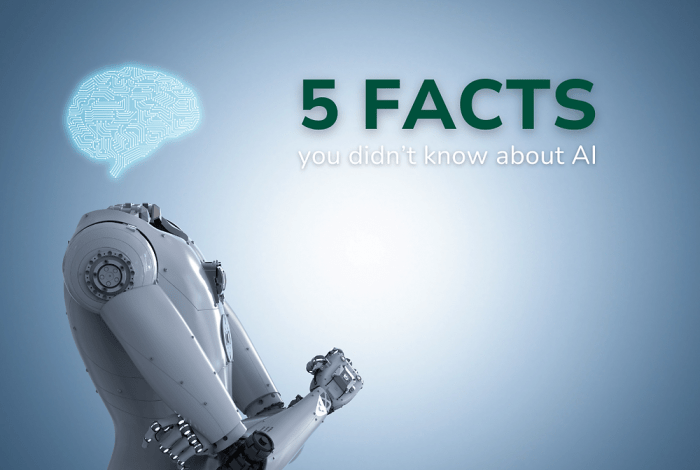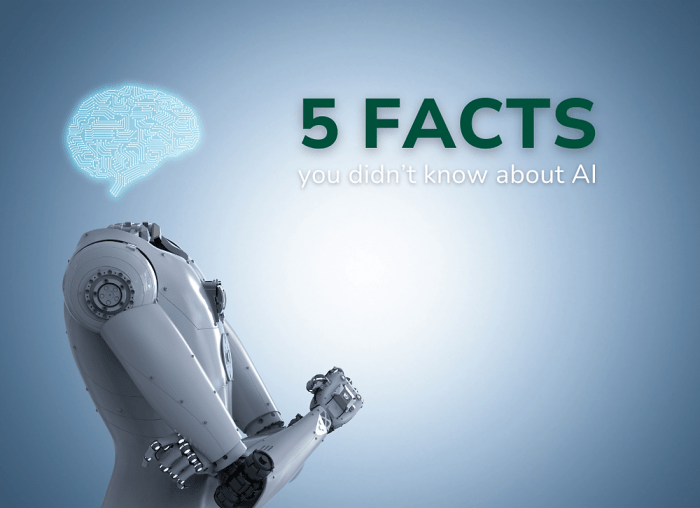
What you need to know about AI? This exploration dives deep into the fascinating world of Artificial Intelligence, covering everything from its core concepts to its potential future impact. We’ll trace the history of AI, examine different types of AI, and explore the wide-ranging applications in various sectors. From healthcare to finance, AI is rapidly transforming industries and our daily lives.
We’ll also consider the ethical implications and potential societal changes that AI might bring.
The core of this exploration is to understand the different types of AI, like machine learning and deep learning, and how they function. This includes looking at the strengths and limitations of each approach and how they are being used to solve real-world problems. We’ll also unpack the ethical considerations, examining the potential biases and responsibilities associated with AI development.
Furthermore, we will envision the future of AI, exploring potential scenarios and its possible impact on the economy and society.
Artificial Intelligence: A Deep Dive
Artificial intelligence (AI) is rapidly transforming our world, from the personalized recommendations on our streaming services to the sophisticated algorithms powering self-driving cars. It encompasses a broad range of techniques and applications, and understanding its core concepts is crucial for navigating this evolving landscape. This exploration delves into the foundations of AI, its historical development, and the diverse branches of this powerful technology.AI, at its core, aims to create systems that can mimic human intelligence.
This includes tasks such as learning, problem-solving, decision-making, and understanding language. Different approaches and methods have been employed to achieve these goals, leading to the diverse branches of AI.
Core Concepts of Artificial Intelligence
AI encompasses various subfields, each with its specific focus and techniques. These include machine learning, deep learning, natural language processing, computer vision, and robotics. Understanding these subfields helps to appreciate the breadth and depth of AI applications.
Historical Overview of AI Development
The field of AI has a rich history, marked by periods of excitement, setbacks, and renewed interest. Early pioneers laid the groundwork for modern AI, with key milestones such as the Dartmouth Workshop in 1956, considered the birth of AI as a formal field. Subsequent decades saw periods of both progress and challenges, leading to advancements in various techniques and algorithms.
The exponential growth in computing power and the availability of massive datasets have fueled a resurgence of AI in recent years, resulting in remarkable progress in areas like image recognition, natural language understanding, and game playing.
Narrow vs. General AI
Narrow AI, also known as weak AI, focuses on specific tasks. Examples include spam filters, recommendation systems, and facial recognition software. These systems excel at their designated functions but lack the general intelligence of humans. General AI, or strong AI, aims to create systems that possess human-level intelligence and can perform any intellectual task a human can.
This remains a significant challenge, and the potential implications of achieving general AI are vast and complex. One area of ongoing research focuses on creating systems that can learn and adapt in diverse environments, similar to human cognitive abilities.
So, you want to know about AI? It’s a rapidly evolving field, impacting everything from healthcare to international trade policies. Understanding how things like Trump’s tariffs affected American healthcare is key to grasping the broader implications of technological advancements. For example, trumps tariff american health care effects highlight how policy decisions can influence technological development and market trends.
Ultimately, to truly understand AI, you need to look beyond the technology itself and consider its broader societal and economic contexts.
AI Types and Applications
| AI Type | Definition | Example Application |
|---|---|---|
| Machine Learning | Algorithms that allow computer systems to learn from data without explicit programming. | Spam filtering, personalized recommendations on e-commerce sites |
| Deep Learning | A subfield of machine learning that uses artificial neural networks with multiple layers to analyze complex data. | Image recognition, natural language processing, medical diagnosis |
| Natural Language Processing (NLP) | Enables computers to understand, interpret, and generate human language. | Chatbots, language translation software, sentiment analysis |
| Computer Vision | Allows computers to “see” and interpret images and videos. | Self-driving cars, medical image analysis, security systems |
| Robotics | The design, construction, operation, and application of robots. | Industrial automation, surgical robots, exploration robots |
Types of AI

Artificial intelligence is rapidly evolving, branching into diverse subfields. Understanding these different types is crucial for appreciating the breadth and potential of AI. This exploration delves into the key categories of AI, highlighting their unique characteristics, strengths, and limitations.Different types of AI tackle various tasks and employ distinct approaches. This allows for specialized solutions tailored to specific needs, from automating simple tasks to handling complex, nuanced problems.
The categorization helps us understand the capabilities and limitations of each type, enabling more informed decisions about AI applications.
Machine Learning
Machine learning (ML) is a core component of AI, enabling systems to learn from data without explicit programming. Instead of being explicitly programmed for every task, ML algorithms identify patterns and relationships within data, allowing them to make predictions or decisions. This learning process is iterative, meaning that as more data is fed into the system, its performance improves.ML algorithms are categorized into several types, each with unique strengths and weaknesses.
Supervised learning, for example, uses labeled data to train models, while unsupervised learning identifies patterns in unlabeled data. Reinforcement learning, on the other hand, involves an agent interacting with an environment and learning through trial and error.The strength of ML lies in its adaptability and ability to handle complex tasks. However, the quality of the training data significantly impacts the performance of the model.
If the data is biased or incomplete, the resulting model may exhibit similar biases or make inaccurate predictions.
Deep Learning
Deep learning (DL) is a specialized subset of machine learning that employs artificial neural networks with multiple layers. These deep neural networks are capable of learning intricate patterns and representations from data, making them highly effective for tasks involving complex data, like image recognition and natural language processing.The strength of deep learning lies in its ability to automatically learn complex features from raw data, often outperforming traditional machine learning methods.
However, deep learning models can be computationally expensive to train and require substantial amounts of data. Additionally, the “black box” nature of these models can make it difficult to understand how they arrive at their conclusions. This “black box” effect is often cited as a major limitation in real-world applications. For example, while a deep learning model might accurately classify images, it might not explain
why* it classified a particular image in a certain way.
So, you’re curious about AI? It’s a fascinating field, but understanding its impact requires looking beyond the tech itself. Think about how your choices as an individual contribute to the development and application of AI. For example, reading an essay like individual action matters essay helps us appreciate how our daily decisions shape the world around us, even when it comes to something as complex as AI.
Ultimately, understanding AI means recognizing that individual action matters profoundly in how it evolves and affects our lives.
Natural Language Processing
Natural language processing (NLP) focuses on enabling computers to understand, interpret, and generate human language. NLP algorithms are used in various applications, from machine translation to chatbots and sentiment analysis. Key aspects of NLP include text analysis, speech recognition, and language generation.NLP algorithms leverage various techniques to understand and process human language, including statistical models, rule-based systems, and neural networks.
While NLP has made significant progress, challenges remain in handling the nuances and complexities of human language, such as ambiguity, slang, and cultural context. For instance, a machine might struggle to interpret sarcasm or humor in text.
Comparison of AI Techniques
| AI Type | Key Algorithm | Typical Use Case |
|---|---|---|
| Machine Learning | Decision Trees, Support Vector Machines, Naive Bayes | Spam filtering, fraud detection, customer churn prediction |
| Deep Learning | Convolutional Neural Networks (CNNs), Recurrent Neural Networks (RNNs), Transformers | Image recognition, natural language processing, speech recognition |
| Natural Language Processing | Hidden Markov Models (HMMs), Recurrent Neural Networks (RNNs), Transformers | Machine translation, chatbots, sentiment analysis |
Applications of AI
Artificial intelligence is rapidly transforming various sectors, from healthcare to finance, and its impact on our daily lives is undeniable. AI’s ability to analyze vast amounts of data and make predictions has opened up new possibilities for efficiency, innovation, and personalized experiences. This section delves into real-world applications of AI, highlighting its impact across diverse industries.
Everyday AI Interactions
AI is woven into the fabric of modern life, often without us even realizing it. Smart assistants like Siri and Alexa utilize AI for voice recognition and natural language processing to fulfill requests and answer questions. Personalized recommendations on streaming services and e-commerce platforms leverage AI to tailor content and products to individual preferences. These everyday examples showcase the seamless integration of AI into our daily routines.
AI in Healthcare
AI is revolutionizing healthcare by improving diagnostics, treatment planning, and drug discovery. AI-powered tools can analyze medical images (X-rays, MRIs) to detect anomalies with greater accuracy and speed than human radiologists. These tools can also assist in predicting patient risk and personalize treatment plans based on individual genetic and medical histories. AI algorithms can accelerate drug discovery by identifying potential drug candidates and simulating their effects.
AI in Finance
AI plays a critical role in the financial sector, enhancing security, fraud detection, and risk management. AI algorithms can analyze financial transactions in real-time to identify potentially fraudulent activities. These algorithms can also assess credit risk more accurately and efficiently, leading to better lending decisions. AI-powered chatbots provide 24/7 customer support and assist with financial transactions.
AI in Transportation
Self-driving cars, powered by AI, represent a significant advancement in transportation. AI algorithms enable these vehicles to perceive their surroundings, make decisions, and navigate safely. AI also optimizes traffic flow, reducing congestion and improving transportation efficiency. AI-powered systems can predict maintenance needs and optimize logistics, reducing operational costs.
AI in Customer Service
AI-powered chatbots and virtual assistants are increasingly used to provide customer service. These tools can answer frequently asked questions, resolve simple issues, and provide immediate support to customers. AI can analyze customer feedback to identify areas for improvement and personalize the customer experience. This leads to greater efficiency and cost savings for businesses.
AI in Personalized Recommendations
AI algorithms are employed extensively to personalize recommendations for users across various platforms. By analyzing user data, AI can predict preferences and tailor content, products, and services to individual needs. This leads to a more engaging user experience and drives higher customer satisfaction.
Table of AI Applications in Different Industries
| Industry | Specific Tasks Performed by AI | Impact |
|---|---|---|
| Healthcare | Analyzing medical images, predicting patient risk, personalizing treatment plans, accelerating drug discovery | Improved accuracy and speed in diagnostics, personalized treatments, faster drug development |
| Finance | Fraud detection, risk assessment, customer service, algorithmic trading | Enhanced security, better lending decisions, improved customer experience, increased efficiency |
| Transportation | Self-driving cars, traffic optimization, logistics optimization, predictive maintenance | Increased safety, reduced congestion, optimized routes, reduced operational costs |
| Customer Service | Answering questions, resolving issues, providing support, analyzing customer feedback | Improved customer experience, reduced response times, cost savings |
| E-commerce | Personalized recommendations, product discovery, inventory management, targeted advertising | Increased sales, enhanced customer satisfaction, improved efficiency |
Ethical Considerations of AI

Artificial intelligence, while offering immense potential for progress, presents complex ethical dilemmas. As AI systems become more sophisticated and pervasive, careful consideration of their potential impact on society is crucial. This section delves into the ethical challenges surrounding AI development and deployment, focusing on bias, fairness, transparency, and accountability.
Potential Risks of Unchecked AI Development
The rapid advancement of AI raises concerns about unintended consequences. Unregulated development could lead to unforeseen societal disruptions. Furthermore, the lack of ethical frameworks to guide AI design and deployment could result in harmful applications. Examples of potential risks include the exacerbation of existing societal inequalities and the erosion of human control over critical systems.
Bias in AI Systems
AI systems learn from data, and if that data reflects existing societal biases, the AI will likely perpetuate them. This can lead to discriminatory outcomes in areas like loan applications, criminal justice, and hiring. For example, facial recognition systems trained primarily on images of white men may perform poorly on images of people from other racial or ethnic groups.
Such bias can have profound and lasting negative impacts on individuals and communities.
Fairness and Equity in AI, What you need to know about ai
Ensuring fairness and equity in AI systems is a significant challenge. AI systems should treat all individuals fairly, regardless of their background or characteristics. However, inherent biases in data and algorithms can lead to unequal outcomes, further exacerbating existing inequalities. For instance, an AI system used to assess risk for loan applications might unfairly discriminate against certain demographic groups.
Transparency and Explainability in AI
Understanding how AI systems arrive at their decisions is essential for building trust and ensuring accountability. Many AI systems, particularly those based on deep learning, operate as “black boxes,” making it difficult to determine why a specific decision was made. This lack of transparency can lead to concerns about fairness and accountability. For example, in healthcare, if an AI system misdiagnoses a patient, understanding the reasoning behind the diagnosis is crucial for corrective action.
Accountability for AI Systems
Determining accountability for errors or harms caused by AI systems is a complex issue. As AI systems become more autonomous, attributing responsibility for outcomes becomes challenging. Defining clear lines of accountability is essential for preventing misuse and promoting responsible AI development. Consider the example of a self-driving car involved in an accident. Who is responsible: the manufacturer, the programmer, or the AI itself?
Comparison of Ethical Frameworks for AI
| Ethical Framework | Key Principles | Strengths | Weaknesses |
|---|---|---|---|
| Utilitarianism | Maximize overall well-being | Focuses on maximizing positive outcomes | Can justify actions that harm a minority |
| Deontology | Follow moral rules and duties | Provides clear guidelines for actions | May not be flexible enough to handle complex situations |
| Virtue Ethics | Develop good character traits | Focuses on the moral character of the developer and user | Difficult to define specific guidelines for actions |
| Rights-Based Ethics | Protect fundamental human rights | Prioritizes individual rights and freedoms | May conflict with other ethical considerations |
Future of AI
The relentless march of Artificial Intelligence promises a future profoundly intertwined with human life. From automating mundane tasks to revolutionizing industries, AI’s influence is poised to reshape our world in ways we are only beginning to comprehend. This transformation will demand careful consideration of its potential benefits and challenges, ensuring a future where AI serves humanity’s best interests.
AI is rapidly changing the world, and it’s crucial to understand its potential impact. Recent events like the ICE administrative error in deporting a Maryland man to El Salvador, highlighted here , show how AI systems, even when seemingly neutral, can have unintended and serious consequences. We need to be mindful of these complexities as AI continues to shape our lives and future.
AI Integration in Daily Life
AI’s infiltration into our daily lives is already happening, from personalized recommendations on streaming services to smart assistants managing our schedules. This integration is projected to deepen, affecting every aspect of our existence. Smart homes will become increasingly sophisticated, proactively managing energy consumption and security. Autonomous vehicles will become more commonplace, revolutionizing transportation and logistics. AI-powered healthcare will provide more precise diagnoses and personalized treatments, potentially extending lifespans and improving quality of life.
These changes will undoubtedly necessitate adjustments in how we interact with technology and each other.
Impact on Human Employment
The rise of AI is not without its potential to disrupt the job market. Many routine tasks currently performed by humans are likely to be automated, prompting a need for workforce adaptation. However, the very nature of work itself is expected to change, demanding new skills and competencies. Existing jobs may be augmented by AI, not replaced outright.
This transition necessitates proactive measures like reskilling and upskilling programs to equip the workforce for the challenges and opportunities of the future. The need for adaptable and innovative individuals will become more crucial than ever.
Future Applications of AI
AI’s potential applications are vast and diverse, spanning various fields and industries.
- Healthcare: AI can assist in diagnostics, drug discovery, and personalized medicine, potentially leading to earlier diagnoses and more effective treatments. Machine learning algorithms can analyze medical images with greater accuracy than human specialists, leading to better diagnoses and faster treatment options. AI can also personalize treatment plans based on individual patient characteristics, optimizing outcomes. Challenges include ensuring data privacy and algorithmic bias in medical applications.
- Manufacturing: AI-powered automation in manufacturing processes can improve efficiency, reduce costs, and enhance product quality. Predictive maintenance using AI can identify potential equipment failures before they occur, preventing costly downtime. AI can optimize production lines based on real-time data, ensuring efficient resource allocation. However, the implementation of such systems may require significant upfront investment and necessitate training for the workforce.
- Education: AI can personalize learning experiences, adapting to individual student needs and learning styles. AI tutors can provide customized support, addressing knowledge gaps and reinforcing strengths. AI can also automate administrative tasks, freeing up educators to focus on student interaction and development. Challenges include ensuring equitable access to AI-powered educational tools and addressing potential biases in the algorithms.
- Environmental Protection: AI can analyze vast datasets to identify patterns in environmental changes, predict natural disasters, and optimize resource management. AI-powered sensors can monitor pollution levels and identify areas requiring intervention. AI can also optimize energy consumption in buildings and transportation systems, reducing our environmental footprint. Challenges include ensuring the responsible use of AI in environmental monitoring and the need for large, high-quality datasets.
AI and the Human Experience: What You Need To Know About Ai
AI is rapidly transforming our world, impacting not just industries and processes but also the fundamental human experience. From how we create and learn to how we make decisions and interact with technology, AI’s influence is profound. This exploration delves into the multifaceted ways AI is shaping our lives, highlighting both the opportunities and challenges presented by this powerful technology.
Impact on Creativity
AI is not meant to replace human creativity but to augment it. Tools like generative AI models can provide artists, writers, and musicians with new avenues for exploration and inspiration. These tools can assist in brainstorming, generating initial drafts, or even creating novel artistic pieces. This collaboration can lead to new styles, unique perspectives, and an expansion of creative expression beyond what is currently possible.
Impact on Problem-Solving
AI algorithms excel at analyzing vast datasets and identifying patterns that humans might miss. This capability empowers researchers, scientists, and engineers to tackle complex problems in medicine, climate change, and materials science. AI can assist in identifying potential solutions, simulating outcomes, and ultimately leading to faster progress in solving critical issues.
Impact on Decision-Making
AI can provide valuable insights and data to support human decision-making. In fields like finance, healthcare, and business, AI algorithms can analyze market trends, patient data, and operational metrics, offering valuable insights and recommendations. However, it’s crucial to remember that AI should be used as a tool to support, not replace, human judgment.
Augmenting Human Capabilities
AI systems can augment human capabilities in many ways. For instance, AI-powered prosthetics can restore lost function, and AI-driven tools can help people with disabilities perform tasks that were previously inaccessible. In the workplace, AI can automate repetitive tasks, freeing up human workers to focus on more creative and strategic endeavors.
New Forms of Human-Computer Interaction
AI is driving the development of new, more intuitive forms of human-computer interaction. Natural language processing allows us to interact with computers using everyday language, while virtual assistants and chatbots make it easier to access information and complete tasks. This increased ease of interaction can lead to a more seamless and integrated relationship between humans and technology.
AI Effect, Human Impact, and Example Scenario
| AI Effect | Human Impact | Example Scenario |
|---|---|---|
| AI-powered design tools | Increased creativity and design efficiency | A graphic designer uses an AI tool to generate variations of a logo, quickly exploring different aesthetics and concepts. |
| AI-driven medical diagnostics | Improved accuracy and speed in diagnosis | An AI algorithm analyzes a patient’s medical images and identifies potential anomalies, assisting doctors in early detection and treatment of diseases. |
| AI-assisted financial planning | Enhanced financial decision-making | An individual uses an AI-powered financial planner to analyze their investment portfolio, providing personalized recommendations and risk assessments. |
| AI-powered language translation | Facilitates global communication and collaboration | A researcher communicates with collaborators in different countries, using an AI-powered translator to break down language barriers. |
AI and the Economy
Artificial intelligence is rapidly transforming the global economy, presenting both exciting opportunities and potential challenges. Its impact on employment, productivity, and market dynamics is profound and multifaceted. Understanding these implications is crucial for navigating the future of work and fostering sustainable economic growth in the age of AI.
Economic Implications of AI Adoption
AI’s adoption across various sectors is significantly altering economic landscapes. The automation capabilities of AI can lead to increased productivity, but also raise concerns about job displacement. The key is to understand how to manage this transition and create new opportunities.
Job Displacement and New Job Creation
The introduction of AI-powered automation systems may lead to job displacement in certain roles, particularly those involving repetitive or predictable tasks. However, the development and deployment of AI also create new job categories, demanding specialized skills and knowledge. The shift in job demand requires retraining and upskilling initiatives to ensure workers can adapt to the changing job market.
Potential for AI to Boost Productivity and Economic Growth
AI’s ability to automate tasks and analyze data can significantly boost productivity across various industries. This increased efficiency can lead to cost reductions and increased output, ultimately contributing to economic growth. Companies can leverage AI to optimize processes, personalize customer experiences, and improve decision-making. For example, AI-powered supply chain management systems can improve logistics, reduce waste, and enhance overall efficiency.
Examples of AI Improving Business Efficiency and Creating New Markets
AI is being used in numerous ways to improve business efficiency and create new markets. In manufacturing, AI-powered robots can perform complex tasks with precision and speed, leading to increased output and reduced errors. In finance, AI algorithms can analyze vast amounts of data to identify patterns and predict market trends, enabling better investment decisions. AI-driven personalized recommendations in e-commerce platforms enhance customer engagement and sales.
This demonstrates AI’s ability to revolutionize various sectors, from manufacturing to retail and finance.
Table Comparing Economic Impact of AI Across Different Sectors
| Sector | Job Displacement Potential | New Job Creation Potential | Productivity Increase Potential | Economic Growth Impact |
|---|---|---|---|---|
| Manufacturing | High, especially for repetitive tasks | High, for AI specialists, maintenance technicians, and AI system developers | Very High, through automation and optimization | Significant, leading to increased output and lower costs |
| Retail | Medium, for cashiers and some customer service roles | High, for AI-focused customer service representatives, data analysts, and personalized marketing specialists | Medium, through personalized recommendations and inventory management | Moderate, with potential for increased sales and customer satisfaction |
| Finance | Medium, for some administrative and data entry roles | High, for AI-focused financial analysts, risk managers, and compliance specialists | High, through fraud detection, algorithmic trading, and risk assessment | Significant, leading to improved investment strategies and risk management |
Final Thoughts
In conclusion, what you need to know about AI is multifaceted and constantly evolving. From its historical roots to its future implications, AI is poised to reshape our world in profound ways. Understanding the various types, applications, and ethical considerations is crucial to navigating this rapidly changing landscape. This exploration serves as a starting point for a deeper understanding of this transformative technology and its place in our future.





